#urops design
Explore tagged Tumblr posts
Text
Ancient Egypt’s riches—its pyramids, temples, and treasures—have drawn archaeologists and explorers to the country for centuries. But one student found Egyptian treasure of a different kind, from a time before the pharaohs, in a long-forgotten cardboard box in a Boston University lab: chunks of wood charcoal burned 5,000 years ago that could unlock secrets of ancient life in less prominent villages and worksites across the vast country.
Ranran (Angela) Zhang (CAS’24), a student researcher in BU’s Environmental Archaeology Lab (EAL), designed an Undergraduate Research Opportunities Program project to analyze the charcoal samples to understand how ancient communities along the Nile—described as “the lifeblood of ancient Egypt”—used the plants and trees around them.
With her research—which she will soon submit to an academic journal—Zhang aimed to identify the types of wood ancient Egyptians burned to answer broader questions about humans’ interaction with their surrounding environment. What kind of wood was available to these people? And how were they collecting it? She was especially interested in figuring out whether the settlements the fragments came from were short- or long-term occupations and what kind of lives the everyday people who called them home had.
9 notes
·
View notes
Text
Aspiring to sustainable development
New Post has been published on https://sunalei.org/news/aspiring-to-sustainable-development/
Aspiring to sustainable development

In a first for both universities, MIT undergraduates are engaged in research projects at the Universidad del Valle de Guatemala (UVG), while MIT scholars are collaborating with UVG undergraduates on in-depth field studies in Guatemala.
These pilot projects are part of a larger enterprise, called ASPIRE (Achieving Sustainable Partnerships for Innovation, Research, and Entrepreneurship). Funded by the U.S. Agency for International Development, this five-year, $15-million initiative brings together MIT, UVG, and the Guatemalan Exporters Association to promote sustainable solutions to local development challenges.
“This research is yielding insights into our understanding of how to design with and for marginalized people, specifically Indigenous people,” says Elizabeth Hoffecker, co-principal investigator of ASPIRE at MIT and director of the MIT Local Innovation Group.
The students’ work is bearing fruit in the form of publications and new products — directly advancing ASPIRE’s goals to create an innovation ecosystem in Guatemala that can be replicated elsewhere in Central and Latin America.
For the students, the project offers rewards both tangible and inspirational.
“My experience allowed me to find my interest in local innovation and entrepreneurship,” says Ximena Sarmiento García, a fifth-year undergraduate at UVG majoring in anthropology. Supervised by Hoffecker, Sarmiento García says, “I learned how to inform myself, investigate, and find solutions — to become a researcher.”
Sandra Youssef, a rising junior in mechanical engineering at MIT, collaborated with UVG researchers and Indigenous farmers to design a mobile cart to improve the harvest yield of snow peas. “It was perfect for me,” she says. “My goal was to use creative, new technologies and science to make a dent in difficult problems.”
Remote and effective
Kendra Leith, co-principal investigator of ASPIRE, and associate director for research at MIT D-Lab, shaped the MIT-based undergraduate research opportunities (UROPs) in concert with UVG colleagues. “Although MIT students aren’t currently permitted to travel to Guatemala, I wanted them to have an opportunity to apply their experience and knowledge to address real-world challenges,” says Leith. “The Covid pandemic prepared them and their counterparts at UVG for effective remote collaboration — the UROPs completed remarkably productive research projects over Zoom and met our goals for them.”
MIT students participated in some of UVG’s most ambitious ASPIRE research. For instance, Sydney Baller, a rising sophomore in mechanical engineering, joined a team of Indigenous farmers and UVG mechanical engineers investigating the manufacturing process and potential markets for essential oils extracted from thyme, rosemary, and chamomile plants.
“Indigenous people have thousands of years working with plant extracts and ancient remedies,” says Baller. “There is promising history there that would be important to follow up with more modern research.”
Sandra Youssef used computer-aided design and manufacturing to realize a design created in a hackathon by snow pea farmers. “Our cart had to hold 495 pounds of snow peas without collapsing or overturning, navigate narrow paths on hills, and be simple and inexpensive to assemble,” she says. The snow pea producers have tested two of Youssef’s designs, built by a team at UVG led by Rony Herrarte, a faculty member in the department of mechanical engineering.
From waste to filter
Two MIT undergraduates joined one of UVG’s long-standing projects: addressing pollution in Guatemala’s water. The research seeks to use chitosan molecules, extracted from shrimp shells, for bioremediation of heavy metals and other water contaminants. These shells are available in abundance, left as waste by the country’s shrimp industry.
Sophomores Ariana Hodlewsky, majoring in chemical engineering, and Paolo Mangiafico, majoring in brain and cognitive sciences, signed on to work with principal investigator and chemistry department instructor Allan Vásquez (UVG) on filtration systems utilizing chitosan.
“The team wants to find a cost-effective product rural communities, most at risk from polluted water, can use in homes or in town water systems,” says Mangiafico. “So we have been investigating different technologies for water filtration, and analyzing the Guatemalan and U.S. markets to understand the regulations and opportunities that might affect introduction of a chitosan-based product.”
“Our research into how different communities use water and into potential consumers and pitfalls sets the scene for prototypes UVG wants to produce,” says Hodlewsky.
Lourdes Figueroa, UVG ASPIRE project manager for technology transfer, found their assistance invaluable.
“Paolo and Ariana brought the MIT culture and mindset to the project,” she says. “They wanted to understand not only how the technology works, but the best ways of getting the technology out of the lab to make it useful.”
This was an “Aha!” moment, says Figueroa. “The MIT students made a major contribution to both the engineering and marketing sides by emphasizing that you have to think about how to guarantee the market acceptance of the technology while it is still under development.”
Innovation ecosystems
UVG’s three campuses have served as incubators for problem-solving innovation and entrepreneurship, in many cases driven by students from Indigenous communities and families. In 2022, Elizabeth Hoffecker, with eight UVG anthropology majors, set out to identify the most vibrant examples of these collaborative initiatives, which ASPIRE seeks to promote and replicate.
Hoffecker’s “innovation ecosystem diagnostic” revealed a cluster of activity centered on UVG’s Altiplano campus in the central highlands, which serves Mayan communities. Hoffecker and two of the anthropology students focused on four examples for a series of case studies, which they are currently preparing for submission to a peer-reviewed journal.
“The caliber of their work was so good that it became clear to me that we could collaborate on a paper,” says Hoffecker. “It was my first time publishing with undergraduates.”
The researchers’ cases included novel production of traditional thread, and creation of a 3D phytoplankton kit that is being used to educate community members about water pollution in Lake Atitlán, a tourist destination that drives the local economy but is increasingly being affected by toxic algae blooms. Hoffecker singles out a project by Indigenous undergraduates who developed play-based teaching tools for introducing basic mathematical concepts.
“These connect to local Mayan ways of understanding and offer a novel, hands-on way to strengthen the math teaching skills of local primary school teachers in Indigenous communities,” says Hoffecker. “They created something that addresses a very immediate need in the community — lack of training.
Both of Hoffecker’s undergraduate collaborators are writing theses inspired by these case studies.
“My time with Elizabeth allowed me to learn how to conduct research from scratch, ask for help, find solutions, and trust myself,” says Sarmiento García. She finds the ASPIRE approach profoundly appealing. “It is not only ethical, but also deeply committed to applying results to the real lives of the people involved.”
“This experience has been incredibly positive, validating my own ability to generate knowledge through research, rather than relying only on established authors to back up my arguments,” says Camila del Cid, a fifth-year anthropology student. “This was empowering, especially as a Latin American researcher, because it emphasized that my perspective and contributions are important.”
Hoffecker says this pilot run with UVG undergrads produced “high-quality research that can inform evidence-based decision-making on development issues of top regional priority” — a key goal for ASPIRE. Hoffecker plans to “develop a pathway that other UVG students can follow to conduct similar research.”
MIT undergraduate research will continue. “Our students’ activities have been very valuable in Guatemala, so much so that the snow pea, chitosan, and essential oils teams would like to continue working with our students this year,” says Leith. She anticipates a new round of MIT UROPs for next summer.
Youssef, for one, is eager to get to work on refining the snow pea cart. “I like the idea of working outside my comfort zone, thinking about things that seem unsolvable and coming up with a solution to fix some aspect of the problem,” she says.
0 notes
Text
Aspiring to sustainable development
New Post has been published on https://thedigitalinsider.com/aspiring-to-sustainable-development/
Aspiring to sustainable development
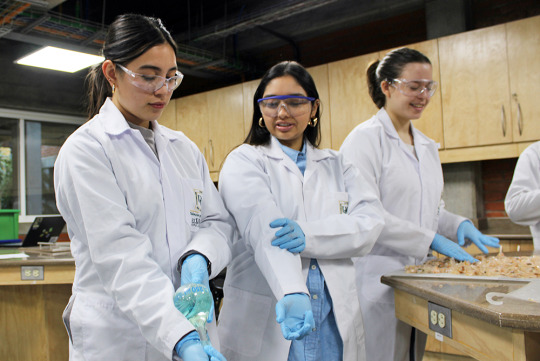

In a first for both universities, MIT undergraduates are engaged in research projects at the Universidad del Valle de Guatemala (UVG), while MIT scholars are collaborating with UVG undergraduates on in-depth field studies in Guatemala.
These pilot projects are part of a larger enterprise, called ASPIRE (Achieving Sustainable Partnerships for Innovation, Research, and Entrepreneurship). Funded by the U.S. Agency for International Development, this five-year, $15-million initiative brings together MIT, UVG, and the Guatemalan Exporters Association to promote sustainable solutions to local development challenges.
“This research is yielding insights into our understanding of how to design with and for marginalized people, specifically Indigenous people,” says Elizabeth Hoffecker, co-principal investigator of ASPIRE at MIT and director of the MIT Local Innovation Group.
The students’ work is bearing fruit in the form of publications and new products — directly advancing ASPIRE’s goals to create an innovation ecosystem in Guatemala that can be replicated elsewhere in Central and Latin America.
For the students, the project offers rewards both tangible and inspirational.
“My experience allowed me to find my interest in local innovation and entrepreneurship,” says Ximena Sarmiento García, a fifth-year undergraduate at UVG majoring in anthropology. Supervised by Hoffecker, Sarmiento García says, “I learned how to inform myself, investigate, and find solutions — to become a researcher.”
Sandra Youssef, a rising junior in mechanical engineering at MIT, collaborated with UVG researchers and Indigenous farmers to design a mobile cart to improve the harvest yield of snow peas. “It was perfect for me,” she says. “My goal was to use creative, new technologies and science to make a dent in difficult problems.”
Remote and effective
Kendra Leith, co-principal investigator of ASPIRE, and associate director for research at MIT D-Lab, shaped the MIT-based undergraduate research opportunities (UROPs) in concert with UVG colleagues. “Although MIT students aren’t currently permitted to travel to Guatemala, I wanted them to have an opportunity to apply their experience and knowledge to address real-world challenges,” says Leith. “The Covid pandemic prepared them and their counterparts at UVG for effective remote collaboration — the UROPs completed remarkably productive research projects over Zoom and met our goals for them.”
MIT students participated in some of UVG’s most ambitious ASPIRE research. For instance, Sydney Baller, a rising sophomore in mechanical engineering, joined a team of Indigenous farmers and UVG mechanical engineers investigating the manufacturing process and potential markets for essential oils extracted from thyme, rosemary, and chamomile plants.
“Indigenous people have thousands of years working with plant extracts and ancient remedies,” says Baller. “There is promising history there that would be important to follow up with more modern research.”
Sandra Youssef used computer-aided design and manufacturing to realize a design created in a hackathon by snow pea farmers. “Our cart had to hold 495 pounds of snow peas without collapsing or overturning, navigate narrow paths on hills, and be simple and inexpensive to assemble,” she says. The snow pea producers have tested two of Youssef’s designs, built by a team at UVG led by Rony Herrarte, a faculty member in the department of mechanical engineering.
From waste to filter
Two MIT undergraduates joined one of UVG’s long-standing projects: addressing pollution in Guatemala’s water. The research seeks to use chitosan molecules, extracted from shrimp shells, for bioremediation of heavy metals and other water contaminants. These shells are available in abundance, left as waste by the country’s shrimp industry.
Sophomores Ariana Hodlewsky, majoring in chemical engineering, and Paolo Mangiafico, majoring in brain and cognitive sciences, signed on to work with principal investigator and chemistry department instructor Allan Vásquez (UVG) on filtration systems utilizing chitosan.
“The team wants to find a cost-effective product rural communities, most at risk from polluted water, can use in homes or in town water systems,” says Mangiafico. “So we have been investigating different technologies for water filtration, and analyzing the Guatemalan and U.S. markets to understand the regulations and opportunities that might affect introduction of a chitosan-based product.”
“Our research into how different communities use water and into potential consumers and pitfalls sets the scene for prototypes UVG wants to produce,” says Hodlewsky.
Lourdes Figueroa, UVG ASPIRE project manager for technology transfer, found their assistance invaluable.
“Paolo and Ariana brought the MIT culture and mindset to the project,” she says. “They wanted to understand not only how the technology works, but the best ways of getting the technology out of the lab to make it useful.”
This was an “Aha!” moment, says Figueroa. “The MIT students made a major contribution to both the engineering and marketing sides by emphasizing that you have to think about how to guarantee the market acceptance of the technology while it is still under development.”
Innovation ecosystems
UVG’s three campuses have served as incubators for problem-solving innovation and entrepreneurship, in many cases driven by students from Indigenous communities and families. In 2022, Elizabeth Hoffecker, with eight UVG anthropology majors, set out to identify the most vibrant examples of these collaborative initiatives, which ASPIRE seeks to promote and replicate.
Hoffecker’s “innovation ecosystem diagnostic” revealed a cluster of activity centered on UVG’s Altiplano campus in the central highlands, which serves Mayan communities. Hoffecker and two of the anthropology students focused on four examples for a series of case studies, which they are currently preparing for submission to a peer-reviewed journal.
“The caliber of their work was so good that it became clear to me that we could collaborate on a paper,” says Hoffecker. “It was my first time publishing with undergraduates.”
The researchers’ cases included novel production of traditional thread, and creation of a 3D phytoplankton kit that is being used to educate community members about water pollution in Lake Atitlán, a tourist destination that drives the local economy but is increasingly being affected by toxic algae blooms. Hoffecker singles out a project by Indigenous undergraduates who developed play-based teaching tools for introducing basic mathematical concepts.
“These connect to local Mayan ways of understanding and offer a novel, hands-on way to strengthen the math teaching skills of local primary school teachers in Indigenous communities,” says Hoffecker. “They created something that addresses a very immediate need in the community — lack of training.
Both of Hoffecker’s undergraduate collaborators are writing theses inspired by these case studies.
“My time with Elizabeth allowed me to learn how to conduct research from scratch, ask for help, find solutions, and trust myself,” says Sarmiento García. She finds the ASPIRE approach profoundly appealing. “It is not only ethical, but also deeply committed to applying results to the real lives of the people involved.”
“This experience has been incredibly positive, validating my own ability to generate knowledge through research, rather than relying only on established authors to back up my arguments,” says Camila del Cid, a fifth-year anthropology student. “This was empowering, especially as a Latin American researcher, because it emphasized that my perspective and contributions are important.”
Hoffecker says this pilot run with UVG undergrads produced “high-quality research that can inform evidence-based decision-making on development issues of top regional priority” — a key goal for ASPIRE. Hoffecker plans to “develop a pathway that other UVG students can follow to conduct similar research.”
MIT undergraduate research will continue. “Our students’ activities have been very valuable in Guatemala, so much so that the snow pea, chitosan, and essential oils teams would like to continue working with our students this year,” says Leith. She anticipates a new round of MIT UROPs for next summer.
Youssef, for one, is eager to get to work on refining the snow pea cart. “I like the idea of working outside my comfort zone, thinking about things that seem unsolvable and coming up with a solution to fix some aspect of the problem,” she says.
#2022#3d#agriculture#algae#America#American#Anthropology#approach#back up#bearing#Brain#Brain and cognitive sciences#chemical#Chemical engineering#chemistry#chitosan#cluster#collaborate#Collaboration#collaborative#Community#computer#consumers#covid#D-Lab#Design#development#economy#engineering#engineers
0 notes
Text
Week 5: Home Away From Home
Hallo! I suppose since I have been living here for over a month now, it may be time to tell you more about… y’know… the actual living situation part of my experience in Aachen. After long work/excursion filled days and Motor Bar filled nights, my lovely apartment in Kastanienweg patiently awaits me.




Some pictures from the UROP excursion to Castle Bruehl last weekend and the Fooseball table at Motor Bar (went undefeated all night😤)
When I tell you this apartment has got me spoiled, I mean it. Maybe my expectations were set too low from my recent-ish tour of my next year apartment in Ann Arbor. From its abnormally small oven better suited to an antique shop and the layer of dust coating just about everything, I believe it possible that that place was designed, furnished, and last-cleaned in the 70s… In comparison, my KaWo (Kastanienweg Wohnheim) apartment is a dream come true (and also somehow half the price but that's a whole rant for another time).
My room is larger than my double dorm at West Quad, and I have it all to myself. Though the IKEA decoration may leave something to be desired aesthetically…, the room feels clean and new and has a certain Gemuetlichkeit I know I’ll miss when I go back to face the reality of Ann Arbor Housing. I share my bathroom and kitchen with only one other roommate. Though not another member of the UROP program, she is also an international student here at RWTH Aachen.



Pictures of my apartment bedroom, shared kitchen, and exterior
Since all UROP students are placed in buildings close to their lab facilities, there is quite a variety in living arrangements. Some students have 2 or 3 roommates. Some live in dorm style buildings with single rooms, personal bathrooms, but a shared kitchen for the whole floor. And on the other side of the spectrum are some lucky students with entire kitchen/bathroom/bedroom units all to themselves. Regardless though, I don’t think you can go too wrong with any of the options. All bedrooms are singles and the dorm student communities are also really fun (in fact, I just went to a Fussball watch party an apartment was throwing for the Germany v. Hungary Euro Cup game and it was a blast).
Video from the Halifax Student Dorm Football Watch Party
It's not quite a home without home-cooked meals, and luckily I’ve prepared my fair share of high-quality cuisine. By this, I mean I have mastered the art of preparing frozen wiener schnitzels and potato pancakes… though the number of vegetables in my meals may leave something to be desired.
Each apartment complex is within a <15 minute bus ride to a grocery store. There are quite a few different options: Aldi, Lidl, REWE, Kaufmann, etc. and I must admit I haven’t been able to discern a significant difference between any of them aside from REWE and ExpressMarkt being “considered” more expensive. Maybe it's partially because my brain is mentally stuck in dollars, but most essential grocery items seem fairly cheap here overall. Milk is consistently 1-2 euros, baked goods are typically less than 3, and not one of my shopping trips has yet totalled above 35 euros.
Of course, even in my perfect KaWo home there have still been some minor inconveniences. Setting up the wifi, lacking a microwave, and the general European distaste for air conditioning have posed some challenges… but with a bedside fan, a saucepan, and a healthy portion of patience, my home in KaWo is something I could happily get used to. :)
Bis Spaeter!
Sarah Bargfrede
Computer Science
UROP Program in Aachen
0 notes
Photo

Есть дизайнерские работы, которые по длине могут быть как целая портянка. Смотришь, вроде много элементов в проекте. А такого, чтобы вызвало восторг, понравилось - так и нету...
А бывают просто первые экраны. Взглянешь и аху... Да, скажешь "ах")))
Смотришь и тащишься.
Сидишь, рассматриваешь каждый элементик неспешно - как потягиваешь хорошее вино или коньяк - наслаждаешься. Неспешно размышляешь о том, что за мысль-идею воплотил автор, какими решениями он это сделал, а как это, а как то...
В общем, не разбор полётов, а приятное времяпровождение)
Начнём. Ссылка на работу - https://dribbble.com/shots/4043488-Larive-Web-Design
1. Фотографии
Фотографий тут аж одна. Но как смотрится!
Автор (кстати зовут Вероника, из Чехии), явно обтравливала фото и работала с маской.
Верхняя обводка - дуга слева направо, обрывающаяся под кистью девушки; приопущенная кисть, которая пальцами как бы указывает на заголовок. В том же направлении скользящие волосы.
И сама девушка, имеющая достаточно прокачанные мышцы), смотрится грациозно на фоне воды и камней.
2. Композиция
По мнению многих профессионалов, месторасположение в композиции человеческой фигуры, а особенно лица - это то место, куда в первую очередь будет притянуто внимание посетителя страницы.
Данная работа хорошо иллюстрирует этот тезис.
Причем эта фишка обыграна мастерски. Внимание зрителя, обратившись к фигуре девушки, скользит по направлению: ниспадающие волосы - обводка - кисть руки - заголовок "Larive". Изящное решение! Вероника - молодчина)
Разумеется, негоже будет не отметить симметрию, которой просто дышит вся работа.
Фоновые блоки, верхнее меню слева, иконки справа, вертикальные элементы вдоль левой и правой стороны экрана. Даже логотип и тот, для гармонии симметрии, размещен в левом нижнем, а не верхнем углу!
3. Типографика
Шрифт заголовка и подзаголовка выбран по уму - как и подобает изысканному парфуму.
Шрифт меню - строг, без засечек. И также в тему.
Дизайнер хорошо владеет принципом соотношения внутреннего и внешнего.
Например, можно заметить, что так как работа у нас вытянута по горизонтали, то боковые поля-отступы (левое и правое) несколько больше верхнего поля (от меню до верхней границы экрана). И в то же время, верхнее поле меньше, чем нижнее (от нижней границы экрана до ближайшего горизонтального элемента)
4. Цвета и стиль
Об основном цвете проекта - светло-розовом - хотелось бы заметить следующее.
Спокойно сижу, смотрю на воду на фото, перевожу взгляд на светло-розовый фоновый блок и возникает предчувствие, что вот-вот и я почувствую запах парфума, о котором идет речь в работе. Офигеть просто!))
Замечу, что всякой психоделической хренью я не балуюсь, так что следует признать очень удачный цветовой выбор Вероники.
5. Что увидел для себя нового в этой работе?
Удачный подбор цвета. Удачный подбор фото.
6. Чтобы изменил/добавил со своей точки зрения в дизайн этой страницы.
Даже такой мысли не возникло) А у Вас?
2 notes
·
View notes
Text
Providing students with a venue to practice presenting has been instrumental in boosting their confidence
One occasion has become a sign of practically every scholastic meeting: the banner meeting. Banners summing up research are attached onto unlimited columns of release sheets. Pioneers in some random field wander through the banners, asking moderators inquiries about their work on the spot. For junior scientists taking an interest in banner meetings unexpectedly, the occasions can be overwhelming.
The Graduate Association of Mechanical Engineers (GAME) and MIT's Department of Mechanical Engineering are attempting to eliminate the terrorizing factor that encompasses banner meetings and introductions. For the 6th year straight, they have composed the Mechanical Engineering Research Exhibition (MERE), which was hung on Oct. 11 in MIT's understudy community. More than 60 alumni understudies, postdocs, and Undergraduate Research Opportunity Program (UROP) understudies introduced their examination undertakings to almost 200 participants in a banner meeting style occasion. The occasion was composed by graduate understudies Crystal Owens and Maytee Chantharayukhonthorn.
"Giving understudies a scene to work on introducing has been instrumental in boosting their certainty," says Evelyn Wang, Gail E. Kendall Professor and office head in mechanical building. "Regardless of whether understudies seek after a vocation in the scholarly world, industry, or government, the capacity to plainly impart about their work will consistently be a significant aptitude."
Nicholas Fang, teacher of mechanical designing and GAME workforce counselor, has seen these aptitudes of specialized correspondence improve in understudies who partake in MERE year-to-year. He likewise considers the to be as an incredible prologue to MIT for first-year graduate understudies and students who are thinking about alumni learn at MIT.
"Support by first-year understudies is essential to this occasion," he clarifies. "New understudies can't sit down in each and every lab to find out about one another's work, so MERE gives them the best chance to become acquainted with the examination in the division overall."
Mechanical building research across MIT is inconceivably various and addresses a wide area of controls, however one regular topic joined the exploration introduced at MERE — each venture offered arrangements and experiences that would one be able to day have unmistakable effect on a worldwide scale.
Arrangements in human wellbeing
Two instances of activities that could affect human wellbeing adopted various strategies to improving our comprehension of cerebrum disease. Cynthia Hajal is utilizing microfluidic chips to develop veins that emulate the human mind. A PhD applicant working with Roger Kamm, Cecil and Ida Green Distinguished Professor of Biological and Mechanical Engineering, Hajal is utilizing microfluidics to study how malignancy metastasizes in the cerebrum.
"The thought is to modify human organs outside of the body to track and test various illnesses," clarifies Hajal. To track and test mind malignant growth, Hajal and her group place cells taken from a human cerebrum into microfluidic channels that are siphoned with supplements and serum. Around seven days after the fact, the cells self-amass into mind vessels. The examination group at that point places tumor cells into the channels and tracks their movement after some time.
"Our cycle causes us picture metastasis in short time periods so we can truly back off and discover what precisely is going on at each phase of the cycle," Hajal includes.
Ali Daher, then, utilizes numerical demonstrating with expectations of one day helping specialists decide the best course of treatment for glioblastoma multiforme cerebrum tumors. "At the point when a specialist is currently thinking of a treatment plan for the patient, they are confronted with numerous difficulties," says Daher, a senior considering mechanical building.
To help advise a specialist's treatment plan, Daher is using numerical models to anticipate how a tumor may respond to treatment plans. Utilizing a diminished request conspire created for liquid frameworks by Pierre Lermusiaux, teacher of mechanical building, Daher chipped away at a calculation that could help specialists figure out what treatments would be most effective.Improving admittance to food and water
Notwithstanding human wellbeing, one more unavoidable topic at MERE this year was the means by which people cooperate with nature. Two tasks specifically focused on how we can improve admittance to food and water, particularly in creating nations.
Sonal Thengane, a postdoc working with Ahmed Ghoniem, the Ronald C. Crane (1972) Professor, is creating composts made of carbon-rich biochar to improve soil quality and harvest yield. Biochar is made by roasting (drying with fire) squander from homesteads or woodlands. "At the point when it is blended into the dirt, the biochar is extremely permeable and holds the dampness and supplements for a more extended time," says Thengane.
Thengane's work has just been tried on a ranch in Kenya and will before long be tried in the United States and India with help from the Abdul Latif Jameel World Water and Food Security Lab (J-WAFS). He and his group have likewise investigated the chance of repurposing the flotsam and jetsam from woods flames and logging buildups, and utilizing it in biochar-based soil. "We are likewise working in California, which has had so many timberland fires as of late," he clarifies. "California has numerous homesteads that could profit by this dirt."
While Thengane is dealing with improving harvest yield and expanding admittance to more secure food, Hannah Varner is wanting to improve admittance to new water in India. An alumni understudy in MIT's GEAR Lab, Varner is currently constructing a model framework that desalinates saline water in India.
"Groundwater holds a ton of potential for tackling the water emergency in places like India and the southwestern United States," says Varner, who works with Associate Professor Amos Winter. The issue with groundwater is it regularly is salty — containing an excess of salt to be consumable. Using displaying and a comprehension of liquid elements and electrochemical cycles, Varner had the option to plan a framework for purpose of-utilization desalination of saline water in India.
"The truly energizing thing is I had the option to plan a framework and afterward carry it to Bangalore this mid year," she says.
Grant champs
All through MERE, members like Varner talked with judges who evaluated their introduction aptitudes. Grants were given to the accompanying understudies:
In front of the rest of the competition introductions: Erin Looney for "Quickening Cleantech Hardware System Development;" John San Soucie for "Gaussian dirichlet Random Fields For Inference Over High Dimensional Categorical Observations;" Nick Selby for "Teachbot : An Education System For Workforce;" and Meghan Huber for "Visual Perception Of Stiffness From Multijoint Motion"
Best first-time moderator: Kuangye Lu for "Far off Epitaxy Of Gaas On Cvd Graphene For Wafer Re Usability And Flexible Electronics"
Best UROP: Helen Read for "Break Toughness Of Polyacrylamide Hydrogels"
Second-place other participants include: Chinmay Kulkarni, Cynthia Hajal, Jongwoo Lee, Francesco Sigorato and Matteo Alberghini, Kiarash Gordiz, Nisha Chandramoorthy, Noam Buckman, Emily Rogers, and Sydney Sroka.
The accompanying moderators were given fair notices: James Hermus, Yeongin Kim, ZhiYi Liang, Lauren Chai, Sanghoon Bae, Antoine Blanchard, Rabab Haider, Scott Tan, and Jaewoo Shim.
Making your own karma
After the finish of the show, Helen Greiner '89, SM '90 conveyed a feature discourse. A pioneer in the field of mechanical technology, Greiner followed her vocation way before a group of people loaded up with mechanical building understudies. Propelled by the Star Wars character R2D2, Greiner took an early enthusiasm for advanced mechanics. In 1990, she helped to establish iRobot.
1 note
·
View note
Text
let me tell you about 6.UAT, mit’s worst invention
so, because mit students are stereotypically very smart and have no social skills, somebody who was very smart decided that there should be a communications requirement that mit students should complete if they want to graduate! this means we don’t require everyone to take generic writing classes they hate, but can do things interesting to them that have been designated “communication-intensive”, a generally good strategy. the main drawback if implemented normally is that if you really, really hate communication you may avoid taking a class with content you want to learn because it’s a communication-intensive class and you’ve already taken enough of those (see also: 6.033). the communication requirement consists, essentially, of two communication-intensive hass classes (CI-Hs) and two communication-intensive classes in your major (CI-Ms).
course 6 decided to throw in the uniquely terrible wrench that also, one of your CI-Ms has to be 6.UAT, a class entirely about presentation skills that was designed by neurotypicals with good presentation skills. the only way to escape 6.UAT is by enrolling in the superurop program and taking 6.UAR, which is approximately the same amount of work but spread over two semesters and you do, like, papers and poster presentations and stuff about your urop project, grad-student-style. or by switching to course 2, which would absolutely wreck my graduation plans but is becoming increasingly tempting. like, i don’t know if whoever invented 6.UAT realizes this, but the really brilliant strength of the ci requirement is that you dON’T have to take a generic class in communications, and requiring all course 6 students to take a generic class in communications... rather defeats the purpose, one might say. also it is a truly dysfunctionally large class because every course 6 has to take it and there are currently 1247 undergrads who have declared course 6 and so on average there will be 200 or so students taking UAT during any given semester. and it’s a presentation skills class that requires a lot of face-to-face time with instructors. brilliant move!
also, if you ever, like, sleep through your recitation section or miss an assignment or something, it’s a major hit to your grade. earlier today i no-showed to an absolutely absurd undirected/casual interview-type conversation, worth 1% of my final grade, and there are no more timeslots left to do it during which i am available. i would absolutely just write it off, except if you don’t complete every assignment you can’t get an A. if my gpa were even slightly less good i might still just write it off tbh
#the trashcan speaks#6.UATblogging#please just let me take two ci-m classes that might actually also teach me technical content. i BEG of you
3 notes
·
View notes
Text
Postdoc: UMichigan.MacroevolutionFreshwaterFishes
*Postdoctoral researcher: Macroevolution of Neotropical Freshwater Fishes* A postdoctoral position in macroevolution of Neotropical Freshwater fishes is available in *Hernn Lpez-Fernndezs lab in the Department of Ecology and Evolutionary Biology and Museum of Zoology at the University of Michigan, Ann Arbor*. We study the macroevolution of highly diverse biodiversity assemblages and the roles of ecological and morphological specialization in driving phylogenetic divergence in fishes. We use fieldwork and natural history collections to combine systematics, comparative morphology, and ecology. We build phylogenies, analyze timing, rates and patterns of lineage and phenotypic diversification, and describe associations between ecology and morphology in a phylogenetic context (more info here: http://bit.ly/2V16T4T ). Broadly, the postdoctoral position will focus on generating and integrating phylogenetic hypotheses and functionally-relevant phenotypic traits of Neotropical freshwater fishes. Within that framework, research projects may include: 1) Developing phylogenetic hypotheses for Neotropical freshwater fishes to provide an integrated timeline for their evolution; 2) Designing and generating cross-clade, functionally relevant phenotypic datasets based on museum specimens; 3) Performing analyses and/or developing phylogenetic comparative approaches to analyze lineage and phenotypic evolution in Neotropical freshwater fishes; 4) Generating phylogenomic hypotheses and/or ecomorphological datasets for analyses of community phylogenetics and assembly evolution in select assemblages. Two or more of these projects would be developed in parallel and opportunities to develop additional or expanded projects within these parameters and for continued collaboration are available. Developing opportunities for involving and mentoring undergraduate students through programs such as U-M UROP (http://bit.ly/2Ed2feJ) are strongly encouraged. For applicants with an interest in Neotropical fishes or macroevolution, the project is an opportunity to engage in large-scale comparative studies with the most diverse freshwater fish fauna on earth. The position offers additional potential for collections-based research on fishes and fieldwork in the Neotropics. The successful applicant will be part of a dynamic group of biodiversity researchers affiliated with the EEB department and the U-M Museum of Zoology, one of the worlds largest ichthyological research collections. Ann Arbor is a great place to live and it is consistently ranked among the top places to live and work in the US (e.g. here ). The city has a vibrant cultural life with something for everyone, including great music, food, craft breweries and outdoors activities. We are also 40 minutes away from downtown Detroit and its many attractions, including the Detroit Institute of Arts, JazzFest, the Riverwalk, Belle Isle Aquarium and the Tigers stadium, among many others. *Position details* Appointment is available for one year and renewable for a second year after successful performance evaluation. Salary is commensurate with experience and includes benefits and employee health insurance eligibility. Start date is May 15, 2019 or a soon as possible thereafter. *Required qualifications* - PhD in Ecology and Evolutionary Biology, Zoology, Ecology or related field - Demonstrable knowledge of bioinformatics associated with phylogenetics, phylogenomics, morphometrics and/or phylogenetic comparative methods, as well as associated data management skills - Demonstrable knowledge of fish anatomy and/or functional morphology - Record of peer-reviewed publications, including lead-author papers in research relevant to the position One or more of the following skills or areas of expertise are desirable - Scripting and analysis pipelines development and documentation of molecular phylogenetic/phylogenomic datasets - Experience working with museum specimens and familiarity with museum cataloguing and databasing practices - 2D and 3D geometric morphometrics, traditional morphometrics, microCT scanning and segmentation software - Previous research experience with Neotropical fish diversity and distribution - Experience mentoring and supervising undergraduate students in research *Application instructions* Please provide a 1-2 page cover letter describing your research experience and future goals describing accomplishments and interests as they pertain to the position, a C.V., and contact information for three academic references. Please submit a single PDF by email to [email protected] with the subject line Postdoctoral Position Application. Informal questions about the position can be directed to the same address. Review of applications will start March 25, 2019 and will continue until the position is filled. Please be aware that I will be in the field with limited email access for part of this period and my ability to answer immediately may be affected. The University of Michigan is an equal opportunity/affirmative action employer, and the university has a strong institutional commitment to diversity among faculty, staff and students. Hernn Lpez-Fernndez, Ph.D. Associate Professor and Associate Curator of Fishes Department of Ecology and Evolutionary Biology and Program in the Environment University of Michigan 1105 N. University Biological Sciences Building, Office 2014 Ann Arbor, MI 48109-1085 Office phone: 734-764-4816 Web: http://bit.ly/2sDIRRR Hernan Lopez-Fernandez via Gmail
1 note
·
View note
Text
2.2 update
sorry i’m late, life hit me in the face its chill
ok ! so the semester is already a couple weeks in, and it’s been doable so far!11!!! this semester im continuing my urop in the civil eng dept doing bio stuff as comp sci kid, so fun times, and i’m also social chair, so i’m planning stuff for my dorm, like movie on Friday, and eventually Escape the Room, Rhode Island trip, and rock climbing! it’s a great procrastination method
here are the classes i’m taking this year!! as first impressions
6.046 - design, analysis of algorithms
ok so 006 was difficult for me, and this class is pretty much a more intense version of 006 with more proofs and math, so uh this class so far is a pit of fire and despair. last tuesday’s lecture was literally like watching one of those ocw lectures on 2x, but in real life, it was quite amazing
6.004 computation structures
pretty cool! i’m very surprised at the amount of course organization and materials in support for this class. it’s also pretty interesting and we had online labs again in this lab, where we got to build CMOS gates and stuff. prof is great, last semester they’re teaching this version of the class T.T
7.03 genetics
my advisor asked me if i was premed when i said i wanted to take this class
21M.301 harmony and counterpoint I
ehhhhh so i was really excited for this class because yay music, but our prof is kinda disorganized? unclear but might change over the semester
i’m also taking orgo not for credit and got my first clicker question right today lmao
5 notes
·
View notes
Text
3 Questions: From the bench to the battlefield
New Post has been published on https://thedigitalinsider.com/3-questions-from-the-bench-to-the-battlefield/
3 Questions: From the bench to the battlefield


Pursuing an Undergraduate Research Opportunity Program project (or two or three) is a quintessential part of the academic experience at MIT. The program, known as UROP, allows students to be “shoulder to shoulder” with faculty, graduate students, and affiliated researchers in MIT’s labs.
Given the plethora of research options and disciplines — everything from getting a crash course in advancing quantum computing to developing neuroprosthetics — it’s no surprise that over 90 percent of undergraduates end up doing a UROP by the time they graduate.
The half-century-old program continues to evolve, adapting to student interest. Consider the experience of rising senior Alexander Edwards, a nuclear and mechanical engineering student and cadet in the Army ROTC program. The Alabama native leveraged his military training thanks to a new fellowship with the Institute for Soldier Nanotechnologies (ISN), an endeavor in which MIT, the U.S. Department of Defense (DoD), and industry partners work together to develop technologies that advance the protection, survivability, and mission capabilities of the U.S. Armed Forces. That fellowship is thanks to a gift of alumnus and ROTC graduate Aneal Krishnan ’02, who commissioned as an infantry officer in the U.S. Army. Here, Edwards and Krishnan describe the unique UROP experience and offer advice for future students.
Q: What was special about having a UROP focused on the challenges that a soldier in the field might face, such as the decades-long challenges of managing excess weight while also having proper ballistic protection?
Edwards: Having a UROP specifically designed for MIT ROTC cadets has allowed me to grow my technical skills while also helping contribute to national defense. The ISN works on an array of different interesting research projects related to defense technologies in any and every STEM discipline.
Team members collaborate on basic research to create new materials, devices, processes, and systems, and on applied research to transition promising results toward practical products useful to the war fighter. U.S. Army members at the ISN also give guidance on soldier protection and survivability needs and evaluate the relevance of research proposed to address these needs.
These collaborations help identify dual-use applications for ISN-derived technologies for firefighters, police officers, other first responders, and the civilian community at large.
Krishnan: The ISN was founded at MIT in 2002, and since its founding, the ISN’s research has been the genesis of over 140 patents, more than 50 startups, and dozens of major transitions of fieldable products. Through the MIT ROTC/ISN fellowship, the ISN benefits from the work of exceptional science and engineering students from MIT, who will also be future military leaders and can bring a real-world perspective to their work. The ROTC cadets benefit by pursuing research as part of their degree in areas in which they are passionate, and that will benefit them in their endeavors after graduation. An overarching success of this fellowship is that there is now a connection between ROTC and MIT’s DoD labs that did not exist in my time as an undergraduate. As a tangible success in this regard, in March 2024, Lt. General Maria Barrett, the commanding general of U.S. Army Cyber Command, conducted a visit at MIT coordinated by both ROTC and the ISN, further elevating the profile of the Institute amongst the DoD top brass.
Q: What was your specific project?
Edwards: My project for the past year has been related to calculating the losses on a radio-photovoltaic thermo-nuclide generator (RTG), also known as a nuclear battery.
My classmate, fellow Army ROTC cadet and fellowship recipient rising junior William Cruz, worked with nanocomputing and piezoelectric fibers to create heartbeat-sensing clothing. He and I can attest that both projects have been incredibly fulfilling, both personally and professionally.
Alongside the UROPs, Mr. Krishnan took us on a day trip in January to Washington D.C., where we were treated to a host of amazing networking opportunities at an array of organizations that seek to transition innovation out of the lab and into the front lines such as Silicon Valley Defense Group, JP Morgan, Peraton, and from In-Q-Tel, the global, not-for-profit strategic investor for the U.S. national security community and America’s allies, hosted by fellow MIT alumnus David LoBosco ’02.
Q: What lessons or takeaways did you gain from this experience? What advice might you share with other students?
Edwards: My main takeaways from all these meetings were, first, the importance of proper communication between the private sector and the government, something that has been lacking of late, and secondly, how I may be able to apply my technical background to consulting, investment, or many other fields.
Overall, I would recommend this program to future MIT ROTC cadets, and both Cadet Cruz and I are exceedingly grateful to Mr. Krishnan and the ISN for the opportunity.
Krishnan: Cadets Edwards and Cruz will now be able to share their experiences with the next class of prospective cadet researchers, thereby increasing the fellowship’s reach and impact. Future initiatives are to expand the fellowship to MIT’s Air Force and Navy ROTC programs, schedule more visits of senior military leaders to both ROTC and ISN, and connect fellowship recipients with ISN startups for career opportunities. And for my part, I’m incredibly fortunate to have met such outstanding Americans as cadets Edwards and Cruz. I’m excited to see where life takes them and hope to be a mentor along the way.
#2024#Advice#air#air force#Alumni/ae#amazing#America#applications#armed forces#Awards#honors and fellowships#background#battery#career#clothing#collaborate#Collaboration#command#communication#Community#computing#consulting#course#crash#cyber#defense#Department of Defense (DoD)#devices#DOD#Education
0 notes
Text
Brussels... und ein Schloss.
Hi everyone! It has been quite the week. My research supervisor was at a conference this week. So, it's been a pretty chill couple of days. This has been the first sunny week in Aachen. Although I love the sun, my body does not fair well in the heat. This of course I can overcome. I hope I'll adapt by the end of my time here in Aachen.
There was another public holiday this past Thursday. I love the German holidays. 🙌 🙌 Me and my friends traveled to Brussels. We began with the Grand Place, Brussel's famous town square named an UNESCO world heritage site in 1998. After the Grand Place, we ventured inside the St Michael and St Gudula Cathedral.
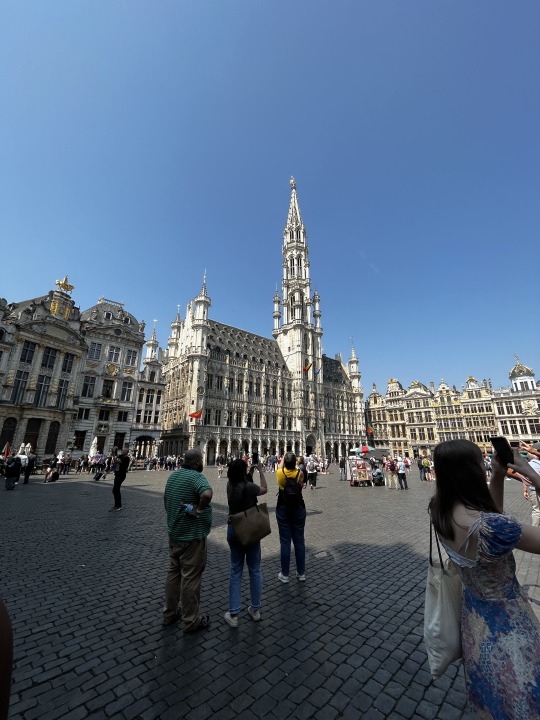
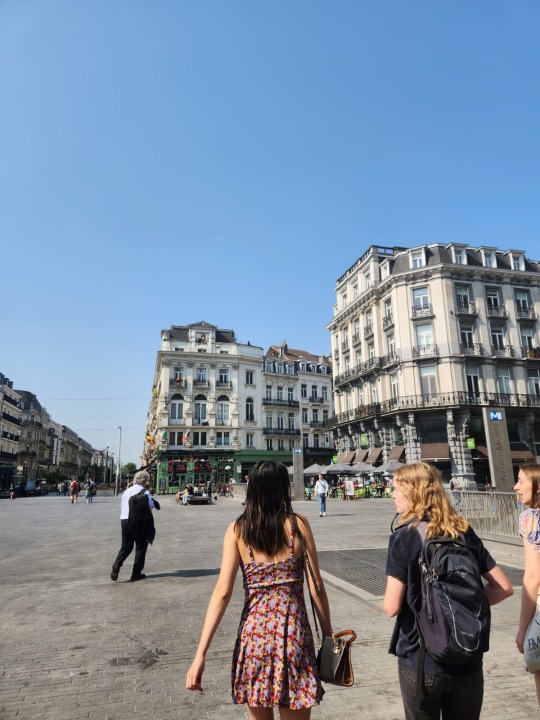
Upon doing some pre-travel Brussels research, I discovered the Trappist monks: a religious order of monks that branched off from the Cistercians. These monks produced bread, cheese, and beer to support themselves and many others. They are quite popular for their beer, Trappist beer. Of all the monasteries in the world that produce beer, Belgium is home to the majority.
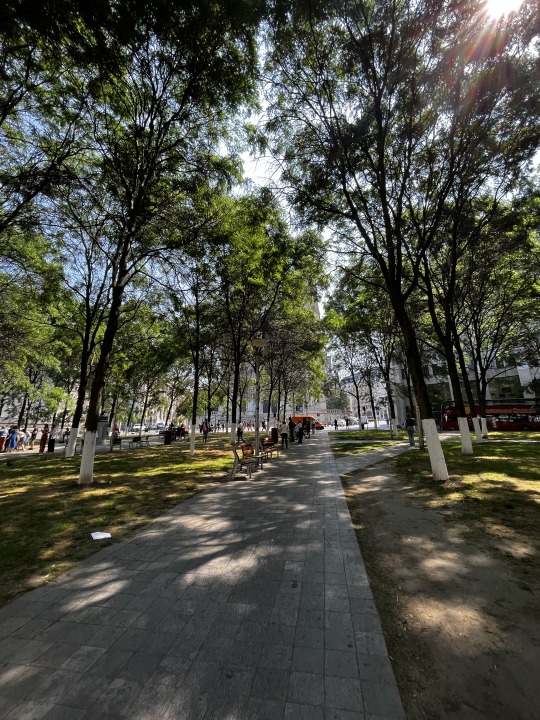
Next up, we headed to Atomium. It was pretty far outside the city center. So we took a train. Honestly, it was pretty cool but not really worth the hour-long travel time. But if you're a fan of absurd goofy-looking structures, this is for you! After Atomium, we enjoyed Mont des arts (Mount or Hill of the Arts).
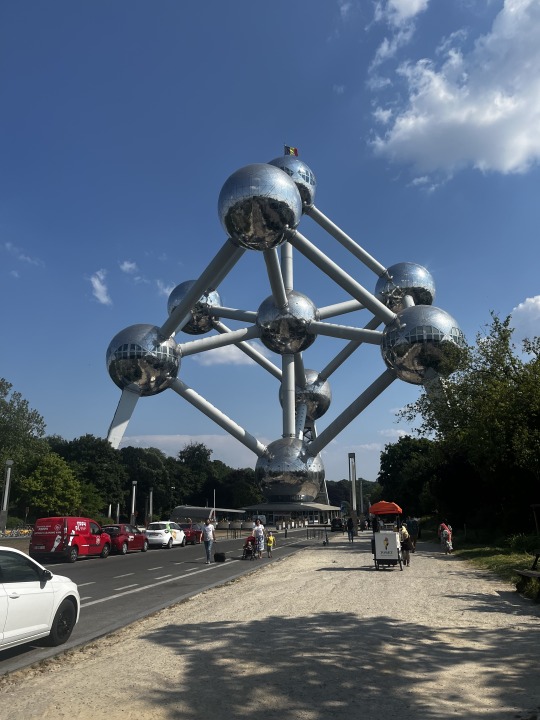
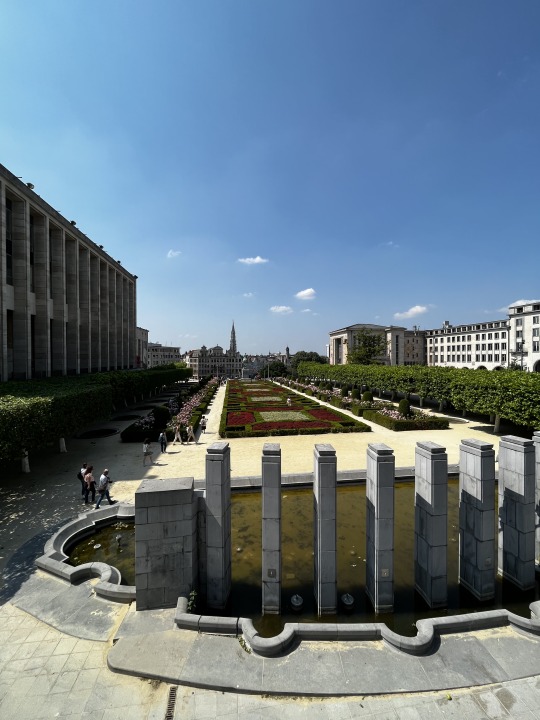
This Saturday, the UROP group headed to Königswinter to see the Drachenfels castle (Schloss). This castle was originally designed for Stephan Sarter, the son of a Bonn innkeeper. He made a fortune through the stock market and by financing the Suez Canal. Sarter never actually lived in this castle, but one of his nephews eventually bought the castle. The hike to the castle was absolutely breathtaking. You could see the Rhine River, Bonn, and even Cologne from the top of the mountain.
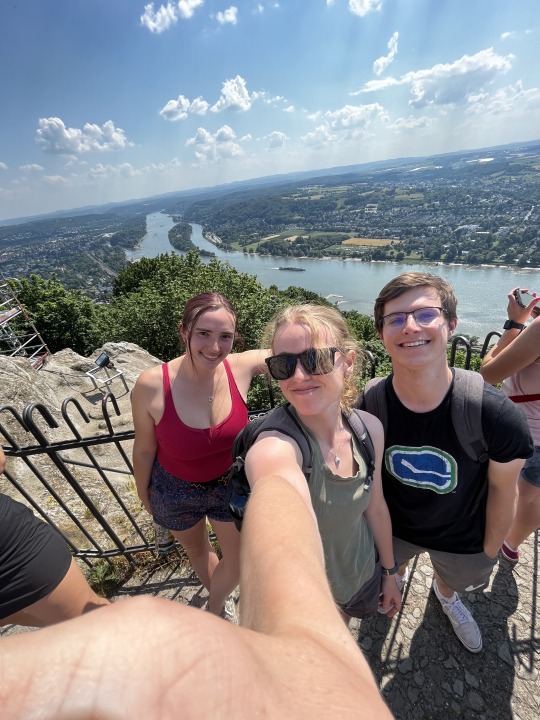
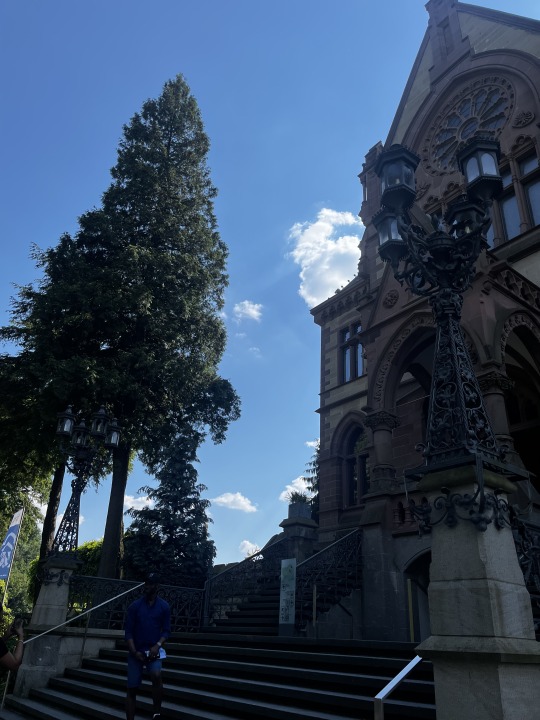
That's all for this week folks! Stay fearless, always.
Ciao!
Kendall Biggs ~ Civil Engineering ~ RWTH Aachen
1 note
·
View note
Photo

Сегодня приглянулся мне арт-веб-концепт. В результате прокачки у Амира, к таким работам появился здоровый интерес)
Итак, рассматриваемая работа - https://dribbble.com/shots/4050383-Art-web-concept-02
1. Фотографии
Фотографии в работе отсутствуют. Наличествует абстрактное изображение. Смотрю, втыкаю. Пытаюсь понять идею.
Интересно понять - чем руководствовался автор, создавая такую картинку? Какой образ им двигал?
Как соотносится мысль "Креативность требует мужества" и изображение справа?
Хм... Пока не очень понимаю.
А может не нужно искать смысл там, где его нет?) Поэтому просто продолжил рассматривать изображение. Приятно смотреть, однако.
2. Композиция
Не смотря на то, что мне непонятна идея изображения - оно легко читаемо. Отсутсвует хаос, безвкусица, нелепое нагромождение элементов.
При этом, на мой взгляд, правая часть работы более "тяжелая" по весу. Левая половина её нед��статочно компенсирует.
Также, рассматривая страницу, я обнаружил некую конкуренцию за внимание между кнопкой "Explore" в левой части и, как я понимаю, кнопкой плеера в правой.
Обратил внимание на некоторое замешательство в себе - а что нажимать? куда приведет нажатие этой кнопки? а вот той? а какая разница между ними?
То есть наличие этих двух элементов в поле моего зрения породило не ясность, а ворох вопросов. Что на мой взгляд не гут.
3. Типографика
Шрифт и его начертания, использованные в макете - без засечек. Смотрится - гармонично и прятно глазу.
По работе видно, что автор понимает принцип соотношения внутреннего и внешнего.
Соотношение верхнего поля (от меню до верхнего края работы) и боковых полей соответствуют формату, который эти поля облачены.
Но вот с нижним полем чуток нескладушка - кнопки соцсетей уж шибко близко к нижнему краю. Делая таким образом нижнее поле меньше верхнего. Что есть не хорошо.
4. Цвета и стиль
Основной цвет - оттенок зеленого. А еще на игре его оттенками построена правая часть работы. Вспомогательным цветом - бирюзовым - выполнена кнопка "Explore" и обводка кнопки плеера.
5. Что увидел для себя нового в этой работе?
Мысль "Креативность требует мужества" побудила посидеть и поразмышлять.
Как часто свое бездействие или боязнь продемонстрировать миру результаты своего труда мы прикрываем идеей, что мы еще не научились, не достаточно компетентны, не достигли совершенства?
А когда оно это совершество наступит? И что такое это гребаное совершенство, из-за отсутствия которого мы отказываемся действовать?
Можно комплексовать, что ты не рисуешь как Ван Гог, или не создаешь дизайн, как топы с дрибла.
С другой стороны, всегда будут существовать люди в твоем ремесле, которые делают лучше тебя.
А с третьей стороны - какого бы условного совершенства не достиг человек - все равно это будет полный отстой перед совершенством Бога.
Выходит, лучше таки последовать идее "Креативность требует мужества" и сделать шаг через свою сцыкотность?
6. Чтобы изменил/добавил со своей точки зрения в дизайн этой страницы.
Я бы добавил, возможно текст или какой-то элемент в левый нижний угол работы. Возможно также какой-то элемент вдоль левого края по горизонтали. Для того, чтобы сбалансировать правую половину проекта.
Также отсимметрил бы заголовок в левой части проекта и верхний блок-куб с вертикальным текстом в правой.
1 note
·
View note
Text
Day 2 - Friday, Sep 6th

Today I slept in - no classes on Friday! On days like these I never know whether to make a real breakfast or just skip it and wait for lunch; today I ended up snacking my way through the lunch hour. I consumed a smoothie made with mango, banana, yogurt, and ice cream. I also consumed a large carrot along with some great hummus from Holy Land, and at some point in the day a bowl of ramen.
I consumed a lot of television in the morning, bouncing around several Netflix shows - and again burning a stick of incense for my room. Once I ate and got ready for the day, I headed to Rapson hall for the monthly design meet up. There I consumed a lot of valuable information from professors at the University who explained several of their respective research projects. I hope to do research with UROP this semester, some of the professors’ work was really interesting to me! Longboarding back from the meeting I consumed a lot of warm sunshine, which really put me in a good mood for the rest of my Friday! I’m trying to absorb all the sunlight I can before the cold sets in.
Back at home, I consumed more Tony Hawk Pro Skater 3 - nostalgia is a powerful force in my consumption! As mentioned in the Design and its Discontents class, many of our own purchases are guided by this as young adults. I buy a lot of specific brands of food and drink just because they remind me of home. Later in the night, I bought a case of beer and left with some friends to check out the new house of another friend. (Sidenote: it came to my attention when buying the brews that my mindset was now shifted, knowing I have this project to do. If I’m collecting empty bottles and cans, for example, will I be subconsciously be changing my consumption habits for the sake of my final project? Did I buy Miller High Life because I like it, or because it looks better in a display than a 30-rack of Hamms? Just a thought.) At the house we consumed a lot of music (and more alcohol) - and it stood out to me that someone had bought a bottle of vodka just because it had the Barstool Sports logo on it. Late at night, once we returned home, my friend and I consumed some NHL 07. The PS2 is getting a lot more mileage than we expected!
0 notes
Text
What is your current obsession?
It’s summer in Boston!! Summer!! Sun!! Beaches!! Happiness!! Exploration!! Random road closures*!! Outdoors!! Fireworks!! NO PSETS!! Events!!
So, this is my first summer NOT with my family in Florida and my first summer in Boston. I will say that although I arrived at MIT last year at the end of August for an FPOP (Freshman Pre-Orientation Program), it is not in any way comparable to spending a full summer here. And even though I spent nine months taking classes over freshman year, the warmth and sun of the summer is nothing like the freezing, sun-less, soul-sucking days of winter. You might be asking, ‘Layal, what are you doing in Boston over the summer? Are you taking classes at MIT or something? Why don’t you have an internship or go abroad, yada yada—’ Well to answer your many questions, I chose to be here! (Also MIT doesn’t offer classes in the summer so that we can all actually get a life ;P )
What exactly do I do? I am here as a Residential Facilitator for the Interphase EDGE Program and a UROP in the Media Lab, Personal Robots group. And what does all of that mean? The Interphase EDGE Program is a summer program for incoming MIT students to help ease their transition into freshman fall. As an RFA, I am responsible for overseeing a ‘cluster’ of three first-years/freshmen/frosh, teaching a workshop/recitation section, of which I teach chemistry, and being present as a guide and resource to help the seventy Interphase scholars. This is probably the most fun job you can get in the summer (though I might be a little biased). With it, I get the satisfaction of being a mentor to the incoming freshmen, the experience of being a TA for a class, and if that already wasn’t cool enough, as bonuses I get breakfast, dinner, and a single in Maseeh with a partial river view! There’s nothing I dislike about this job, and the people I interact with make it worth every moment (and there’s really nothing like being in a single, which I could probably write another entire blog post about). And my UROP is a UROP, which doesn’t explain much. I guess it might not be as good of an explanation as I first thought since any time I do any random craftwork/work not on my computer, my friends ask me if I’m working on my UROP. I mean, sometimes yeah, I am ¯\_(ツ)_/¯
In actuality, the work I do for my UROP surrounds the idea of designing social robots for older adults. I had started working on this UROP in the spring, designing icons that would be used for the interactive part of the study. This summer, I worked on analyzing transcripts from interviews done by my supervisor with respect to her long-term study and designing tools that could be used to make the interactive part of the study low-cost and portable. As it stands, the icons are stored and used on a very expensive HP Sprout which, from experience, is heavy and very hard to transport to the participants. It has been really interesting hearing older adults’ opinions on technology, their life needs, and the idea of social robots catered to them. The UROP allows me to think creatively to complete assigned tasks, and that is my favorite part of the job.
All of this background is here just to set the tone of my summer, a general what have I been up to sort of thing. What I really want to talk about is my new obsession.
Since getting to Boston last year, I have loved exploring the city, or rather, walking across Harvard Bridge as an excuse not to do psets. I have lived in suburbia my entire life, and as tiresome as some aspects of Boston can be, I have fallen in love with the city. Since nowadays I have much more free time than I do during the academic year, I am OBSESSED with exploring more of Boston. The city comes to life over the summer, with a host of events, food, and fun. Here is a list of some of the fun things Boston has to offer that I’ve done in the past two months:
1. Travel to New York City!
Okay, this isn’t exactly Boston, but its location is ideal for a day trip to NYC. A friend of mine is doing an internship there, and so we joined her for 24 hours of fun in the Big Apple. A car rental and five hours later, we were exploring the city. We had bagels for breakfast, roamed around Central Park, had food cart food (big yum), walked along the High Line, stared in awe at the Oculus, and wandered through Times Square. New York City is also accessible by train and by bus, and whatever way you get there, it’s a trip I highly recommend! Though again, I might be biased because there is just something about NYC that makes me fall in love with it every single time I visit.
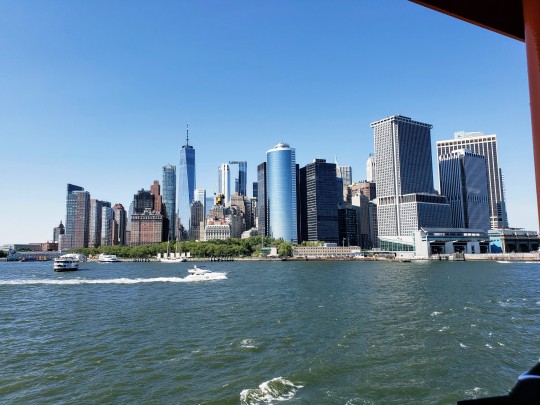
The NYC skyline from the Staten Island ferry

The 9/11 Memorial and the Oculus at the World Trade Center
2. Watch the 4th of July fireworks (and join in on the other festivities)!
If you’re in Boston over the summer, you can’t miss the 4th of July. Like it is physically impossible to avoid this holiday, given that Boston is America’s birthplace. The festivities begin with a flag-raising ceremony at Boston City Hall at 9am, leading to a nice little parade that takes you to the Old State House, where the entirety of the Declaration of Independence is read from the same balcony that it was read from every year since 1776. Throughout the day there are numerous celebrations to get you in a patriotic mood. There is the famous Boston Pops concert that happens across the river on the Esplanade right before the fireworks, which I did not attend but could hear from Memorial Drive.
The fireworks are a very big deal. Large boats that will be lined with fireworks begin to show up on the river from three or four days before the fourth, Harvard bridge is shut down from 4pm the day-of so it can be ready for the show. Rooftops and tall buildings with a river view are lined with people. Since the unofficial best place to watch the fireworks is on the Cambridge side, I collected my work for the day, grabbed a blanket, and sat on a nice, grassy patch of Killian Court when the sun began to set. There were so many people on both sides of the river, an estimated half a million just on the Boston side! And the show was very much worth the wait.
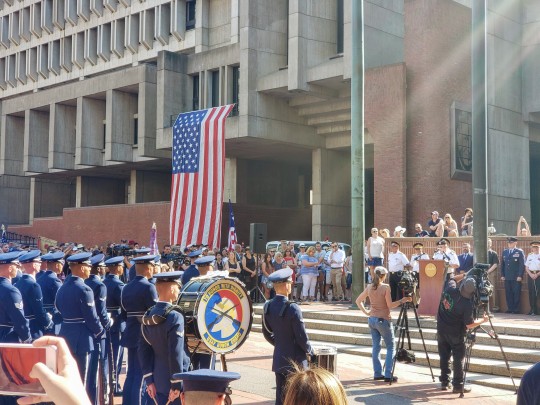
Flag-raising ceremony at Boston City Hall
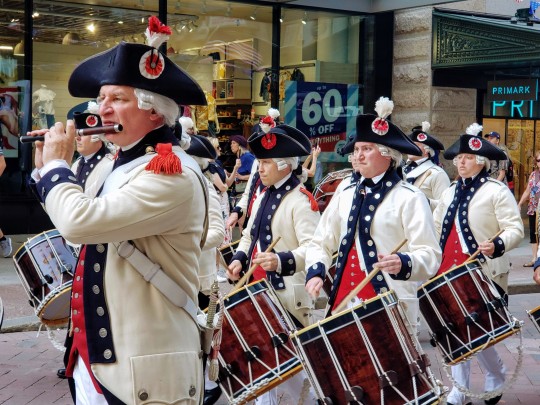
Minutemen marching in the 4th of July Parade to the Old State House
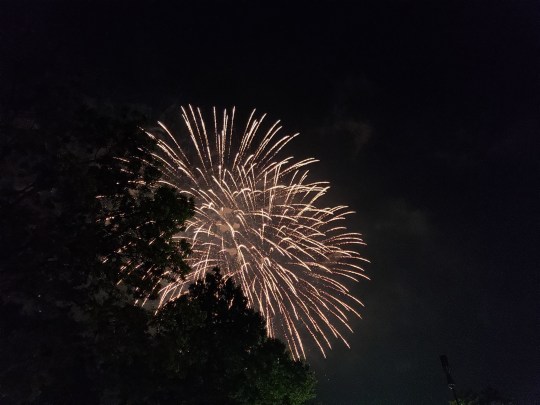
Fireworks!!!
3. Go to Maria’s Pastry Shop!
I am an outlier of sorts in that I don’t like the infamous Mike’s Pastry’s cannolis. I really don’t. But I wasn’t worried because the North End has no shortage of pastry shops or cannoli options to try. I heard a lot about Maria’s Pastry Shop so one weekday morning before I had to go in for my UROP, I took an Uber with friends to eat some freshly baked goods and cannolis. And holy cannoli it was good. 10/10, will eat again.
(I have no pictures of the cannolis, I ate them immediately)
4. Go to Revere Beach!
Walking through Boston, it doesn’t feel like the coast could be so close and accessible, but it is! Just a hop, skip, and jump away from campus is a beach you can visit for $5 roundtrip on the subway. Just take the red line, transfer to orange, and go all the way down the blue line to Wonderland: even the name of the stop expresses how nice the place is. On a really hot summer day, the water is perfectly cool, and the sand is smooth and soft. I’ve made this trip multiple times since I came to MIT, and over the summer I took a trip with a large group of Interphase scholars! It is a very accessible way to get away from campus and return to nature, at the open border between land and water.

Beach Day at Revere!
5. Eat pie at Petsi Pies (and visit the school down the street)!
At the outskirts of Greater Boston is one of the most delicious pie places I’ve ever tried. I was actually introduced to the place by my UROP supervisor when we went to Cohasset to visit some study participants, and I have been enamored ever since. Peach Blackberry with Walnut Crumb. Brown Butter Pecan Pie. It tastes even better than they sound. This would have been a quick trip on the Red Line, but on the day in question, the Red Line was broken :(
After getting there, we walked towards a small park to eat, then to Harvard Square for dinner. While walking there I noticed that the Curious George store was missing from its corner (no! what a travesty!) but then I found out it was moving to Central Square (yay! it will be closer!) so that was fun. Walking through Harvard campus, I felt like I was intruding on the place or something lol. We visited Widener Library to get our complementary Harvard library cards for access to their library and shuttle system, but it was closed for the day. I will be back to Harvard sometime soon for that.
What happened with the cannolis happened with the pies ;(
6. Take the Commuter Rail!
There is a really awesome deal right now that I believe began around when summer started, and that is the $10 unlimited weekend commuter rail pass, valid on Saturdays and Sundays. Some trips on the commuter rail are $10 for a one-way ticket, so this is actually a very good deal. One Saturday, a large group of friends and I took the commuter rail to Manchester-by-the-Sea (yes, like from the movie) and walked over to Singing Beach, a picture-perfect beach, and the most beautiful one I have visited yet. Yes, I’m from Florida. The waves were the clearest blue, the sand, the lightest beige, and the sky was bright with the heat of the sun. The water was perfect.
We then got back on the commuter rail and spent the rest of the day in Rockport, a little seaside town made infamous by its artists, seafood, and quaint, colorful buildings. We took a stroll down Bearskin Neck, ate lobster rolls at Roy Moore’s, and tasted samples of delicious fudge from the Fudgery. All this was a mere hour-long train ride away.
On Sunday, we took the commuter rail west, all on the same $10 pass, and went to a farm to go fruit picking in Sherborn. We walked between peach trees and enjoyed the warm weather with good conversation and laughter. The day ended back in Boston, with a walk through Chinatown.
There are many more great stops on the commuter rail, including Concord, Salem, and Gloucester. I can’t wait to explore more of the commuter rail.

Motif #1 in Rockport
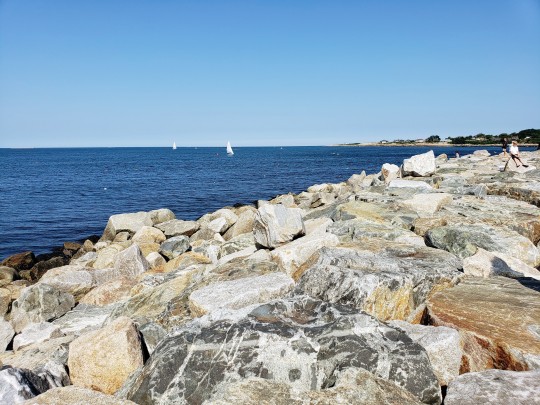
Rocks at Rockport (I understand the name now)
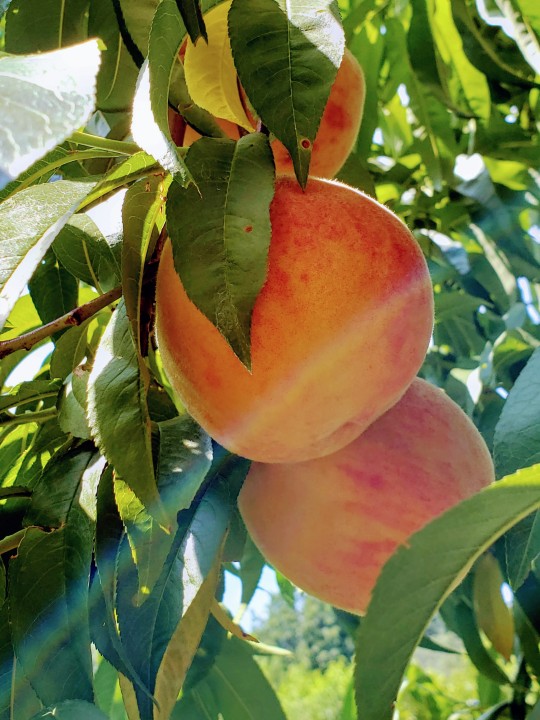
Peaches at Sunshine Farms in Sherborn
My first summer in Boston has been super fun and overall a great success, and I still have about half a month left of it to go. My next few weekends aren’t planned yet, but I can’t wait to see what’s in store!
*This actually happens way too often in the summer that it's kind of getting annoying. Boston’s commute is already a mess: from the red line derailment, the MBTA fare hike, construction and lane closures everywhere, don’t even get me started on rush hour traffic. Mass Ave is at a standstill for…a parade? A street race? Huh? I mean guess the dance party was pretty awesome. And the 4th of July fireworks. I have to admit it’s cool sometimes :P
0 notes
Photo

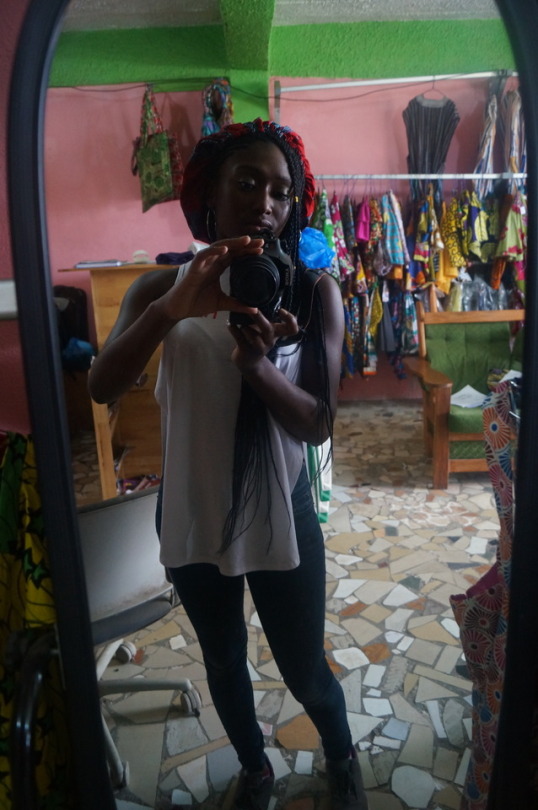
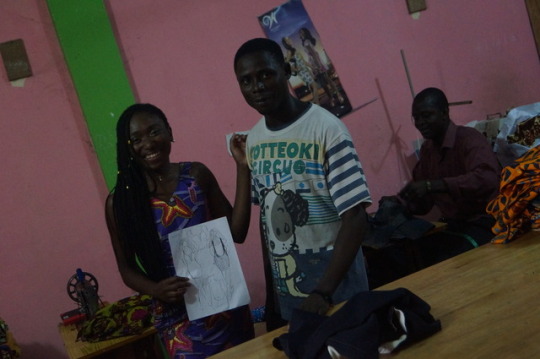
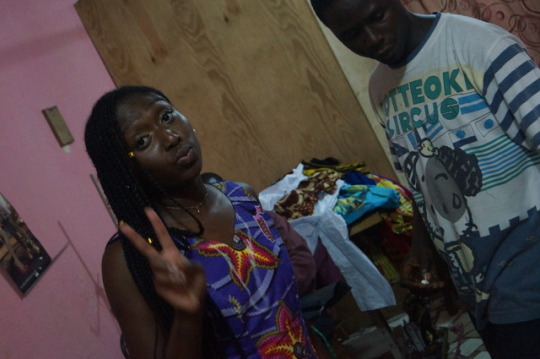
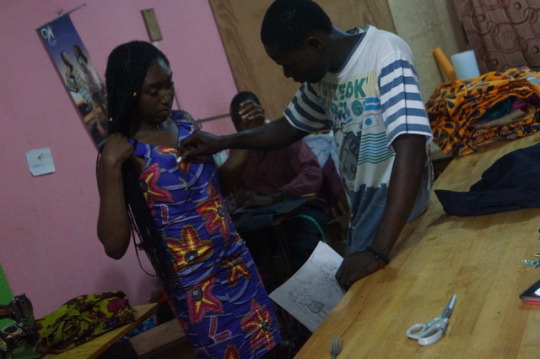

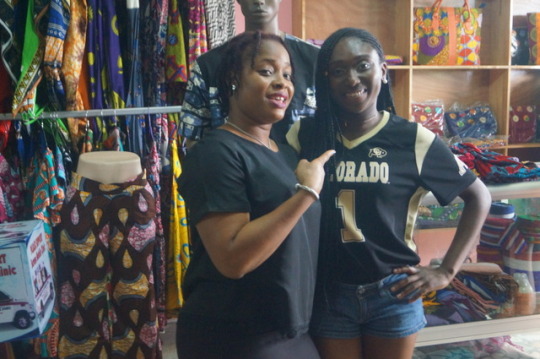
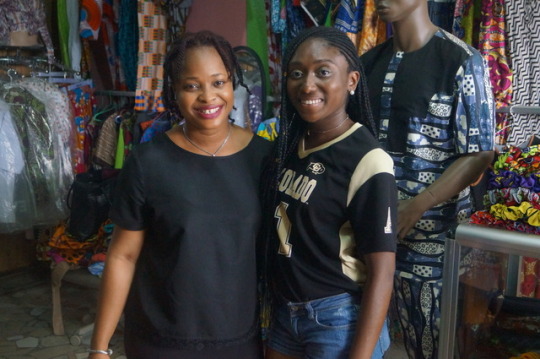
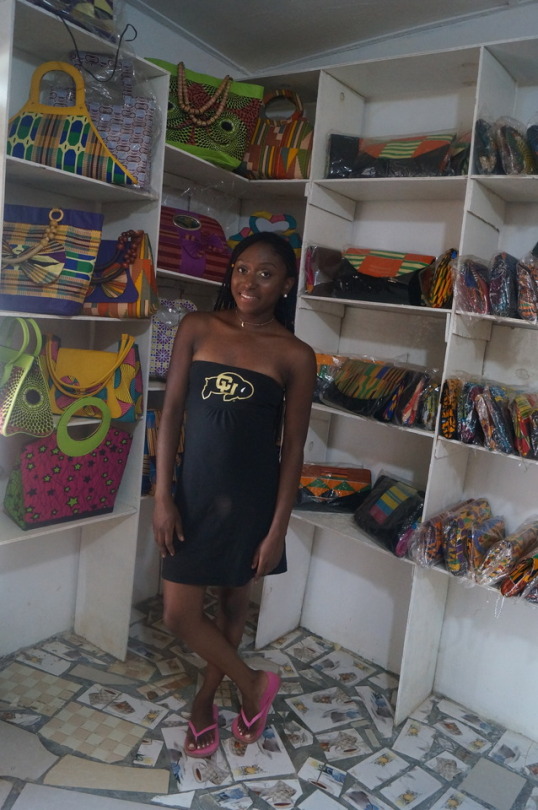
30 Days in Liberia: Completing the “Nymphaea” collection for my brand Guwala da Nele, LLC.
With the help of my university, the University of Colorado Boulder 's CU New Venture Challenge & CU-Boulder Undergraduate Research Opportunities Program (UROP), I have successfully created a collection of garments in Monrovia, Liberia! Upon sales, I plan to come back to with local schools to ensure women and girls have access to computer literacy and STEM skills. I worked with a female tailor shop owner and bought my fabrics from a fabulous lady fabric store owner. I brought my sketches and muslin and these tailors perfectly executed my ideas!
This trip was so surreal. I have been dreaming of being a designer my whole life! I went to fashion school but didn’t take it as seriously as I should have but never lost my passion to make global change one seam at a time. This collection is close to my heart for it lead me to reuniting with my eldest sister from over 7 years since we have last seen each other! It’s given me a chance to see where my parents grew up, talk to people speak out languages and truly immerse myself in my culture. Though it was my first time in Liberia, it certainly wont be my last! I miss you already mama Liberia! See you soon :)
Stay tuned for the collection at the Guwala Da Nele Blog
-Garmai- K. M.
#Liberia#motherland#kpelle#grebo#CUboulder#skobuffs#buffsabroad#UROP#newventurechallenge#NVC#Guwaladanele#GDN#Guwala Da Nele#blackgirlmagic#collection#fashion#fashionschool#Garmai#30daysinliberia
1 note
·
View note
Text
Nos Bastidores - Lisa Su

“Acredito que duas coisas definem se uma pessoa terá sucesso ou não a primeira é o amor que ela recebe de sua família e a segunda é a sua educação!”
Lisa Tzwu-Fang Su ou como é mais conhecida, Dra. Lisa Su, nasceu em 1969 na cidade costeira de Tainan no Taiwan.
Nascida de pais Taiwaneses, Chun-Hwai Su e Sandy Su, emigrou para os Estados Unidos por volta dos três anos. Ambos ela e seu irmão foram encorajados a estudarem matemática e ciência desde crianças, ela tinha por volta dos 7 anos quando seu pai, um estatístico aposentado, começou a ensinar-lhe tabuadas de multiplicação. Sua mãe, uma contadora que mais tarde viria a ser uma empreendedora, lhe ensinou os conceitos de um negócio.
Ainda jovem, Su aspirava ser engenheira, questionada ela disse que “apenas tinha uma imensa curiosidade de saber como as coisas funcionavam.”
Ela tinha 10 anos quando começou desmontando e depois consertando os controles dos carros de brinquedo do seu irmão, ganhou seu primeiro computador no fundamental, um Apple II.
Terminou a escola em 1986 na Bronx High School of Science em Nova York.
Assim seguiu para o Massachusetts Institute of Technology (MIT) no final de 1986, pretendendo cursar Engenharia Elétrica ou Ciência da Computação. Acabou seguindo por Eng. Elétrica, que na época era um dos cursos mais difíceis.
Durante seu primeiro ano, ela trabalhou como assistente de pesquisa de graduação “realizando testes em wafers de silício para alunos da pós-graduação” através do programa de oportunidades para pesquisas (UROP).
O projeto bem como seus trabalhos de verão na Anolog Devices, lhe dispertou o interesse em semicondutores.
Ela permaneceu focada no tópico para o restante de sua educação, passando a maior parte do tempo em laboratórios projetando e ajustando produtos.
Depois de obter seu bacharel em Eng. Elétrica, passou para o mestrado obtendo o mesmo em 1991 através do MIT. De 1990 até 1994 buscou seu PhD ainda através do MIT com seu orientador Dimitri Antoniadis. MIT Technology Review reportou seu artigo como candidato a doutoramento, Su foi “uma das primeiras pesquisadoras a olhar para tecnologia de silício em isoladores(SOI), uma técnica não comprovada para aumentar a eficiência dos transistores, construindo-os sobre camadas de um material isolante ".
Ela se formou com seu PhD em engenharia elétrica do MIT em 1994.
Carreira
1994–1999: Texas Instruments and IBM R&D
Em junho de 1994, Su tornou-se membro da equipe técnica da Texas Instruments, trabalhando no Centro de Dispositivos e Processos de Semicondutores (SPDC) da empresa até fevereiro de 1995.
Naquele mês, a IBM contratou Su como membro da equipe de pesquisa especializada em física de dispositivos, e foi nomeada vice-presidente do centro de pesquisa e desenvolvimento de semicondutores da IBM. Durante seu tempo na IBM, Su desempenhou um "papel crítico" no desenvolvimento da "receita" para fazer as conexões de cobre trabalharem com chips semicondutores em vez de alumínio ", resolvendo o problema de evitar que impurezas de cobre contaminassem. os dispositivos durante a produção ".
Trabalhando com várias equipes de design da IBM nos detalhes do dispositivo, Su explicou, "minha especialidade não era em cobre, mas migrei para onde estavam os problemas". A tecnologia de cobre foi lançada em 1998, resultando em novos padrões da indústria e chips que foram até 20% mais rápidos do que as versões convencionais.
2000–2007: IBM Emerging Products division
Em 2000, Su recebeu uma atribuição de um ano como assistente técnico de Lou Gerstner, CEO da IBM. Posteriormente assumiu o papel de diretora de projetos emergentes, afirmando que "eu era basicamente diretor de mim mesmo - não havia mais ninguém no grupo".
Como chefe e fundadora da divisão de produtos emergentes da IBM, ela administrou uma empresa iniciante e logo contratou 10 funcionários para se concentrarem em biochips e "semicondutores de baixa potência e banda larga".
Seu primeiro produto foi um microprocessador que melhorou a duração da bateria em telefones e outros dispositivos portáteis. A MIT Technology Review nomeou-a como "Top Innovator Under 35" em 2001, em parte devido ao seu trabalho com produtos emergentes.
Também através da divisão, ela representou a IBM em uma colaboração para criar chips de última geração com a Sony e a Toshiba. Ken Kutaragi acusou a colaboração de "melhorar o desempenho dos processadores de máquina de jogos por um fator de 1.000", e a equipe de Su eventualmente surgiu com a idéia de um chip de nove processadores, depois usado para alimentar dispositivos como o Sony PlayStation 3.
A partir de 2006, ela continuou a servir como vice-presidente do centro de pesquisa e desenvolvimento de semicondutores da IBM, mantendo o cargo até maio de 2007.
2007–2011: Freescale Semiconductor
Lisa Su juntou-se à Freescale Semiconductor em junho de 2007 como diretora de tecnologia (CTO), liderando a pesquisa e desenvolvimento da empresa até agosto de 2009.
De setembro de 2008 até dezembro de 2011, atuou como vice-presidente sênior e gerente geral do grupo de redes e multimídia da Freescale e foi responsável pela estratégia global, marketing e engenharia para o negócio de processadores de aplicativos e comunicações incorporados da empresa.
Como chefe do negócio de chips de rede da empresa, a EE Times creditou a ela ajudar a Freescale a colocar "sua casa em ordem", com a empresa solicitando um IPO em 2011.
2012–2014: AMD appointments
Su tornou-se vice-presidente sênior e gerente geral da Advanced Micro Devices (AMD) em janeiro de 2012, supervisionando as unidades de negócios globais da empresa e a "execução de ponta a ponta" dos produtos da AMD.
Nos dois anos seguintes, ela "desempenhou um papel proeminente" ao impulsionar a empresa a diversificar além do mercado de PCs, inclusive trabalhando com a Microsoft e a Sony para colocar chips AMD nos consoles de jogos Xbox One e PS4.
No dia 8 de outubro de 2014, a AMD anunciou a nomeação de Su para presidente e CEO, substituindo Rory Read. Declarou que seu plano para a empresa envolvia concentrar-se em fazer "investimentos tecnológicos corretos", simplificar a linha de produtos e continuar diversificando, afirmando também que ela queria "simplificar" a empresa e acelerar o desenvolvimento de novas tecnologias. Um número de analistas elogiou a nomeação devido às credenciais da Su, observando que a AMD estava buscando crescimento nas áreas de produtos onde a Su tinha "extensa experiência".
2015–2016: AMD diversification
Em fevereiro de 2015, cerca de 40% das vendas da AMD vieram de mercados que não são de PC, como consoles de videogame e dispositivos embarcados. Quando a Su aderiu à AMD em 2012, cerca de 10% das vendas vieram de produtos que não são de PC.
Em maio do mesmo ano, Su e outros executivos da AMD apresentaram uma estratégia de longo prazo para a empresa se concentrar no desenvolvimento de tecnologias computacionais e gráficas de alto desempenho para três áreas de crescimento: jogos, datacenters e mercados de "plataformas imersivas".
Em janeiro de 2016, anunciou que a AMD estava trabalhando em novos chips baseados no FinFET para criar uma nova linha de microprocessadores, produtos, unidades de processamento acelerado (APUs), chips gráficos e designs de chips semi-personalizados para consoles de videogame inéditos.
O valor das ações da AMD subiu em julho de 2016, quando registrou um forte crescimento de receita. A Fortune atribuiu a estatística "impressionante" à Su, afirmando que "continua a executar seu plano de retorno ... os principais ganhos em gráficos e consoles de jogos de vídeo aumentaram os resultados, além de um acordo para licenciar projetos de chips para servidores na China".
Premios e honras
Lisa Su foi reconhecida com uma série de prêmios ao longo de sua carreira. Em 2002, ela foi selecionada como uma das "100 melhores jovens inovadoras" pelo MIT Technology Review, e no ano seguinte a YWCA concedeu-lhe um prêmio por realizações notáveis em negócios. Em 2009, foi nomeada membro do Instituto de Engenheiros Elétricos e Eletrônicos (IEEE), tendo publicado mais de 40 artigos técnicos.
Foi nomeada "Executivo de 2014 do ano" no EE Times e EDN 2014 ACE Awards.
Em 2015, a SFGate a indicou para o prêmio inaugural Visionary of the Year, que "saúda os líderes que se esforçam para tornar o mundo um lugar melhor e impulsionar a mudança social e econômica, empregando novos modelos e práticas de negócios inovadores".
Em 2016, ela foi nomeada uma das "50 mulheres mais poderosas em tecnologia" pelo National Diversity Council e "Outstanding 50 Asian Americans in Business" com o Pinnacle Award pelo Asia American Business Development Center.
Em 2017, foi nomeada "People to Watch" pela HPCWire, "CEO da Top Semiconductor", pela Institutional Investor Magazine e "World's Greatest Leaders" pela Fortune. Su foi novamente nomeada uma das "50 mulheres mais poderosas em tecnologia" pelo Conselho Nacional de Diversidade.
Em 2018, recebeu o UPWARD "Prêmio Mulheres do Ano", "Lifetime Achievement Award" da Greater Austin Asian Chamber, eleita para a Academia Nacional de Engenharia, Fortune # 6 "Empresária do Ano", Global Semiconductor Alliance "Prêmio de Liderança Exemplar Dr. Morris Chang" e Top 50 Women In Tech da Forbes America. Ela também foi nomeada como Presidente do Conselho de Diretores da Global Semiconductor Alliance.
0 notes